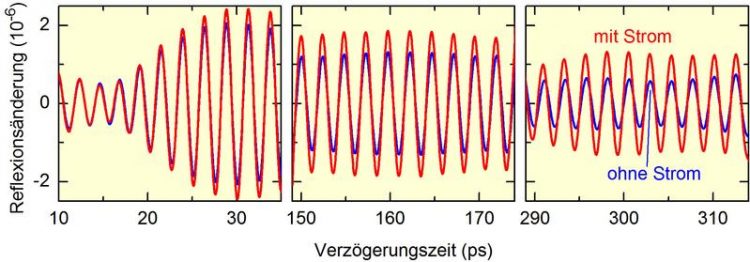Amplification of Sound Waves at Extreme Frequencies

Changes of the sample reflectivity as a function of the delay time after the pump pulse. The observed oscillations are proportional to the instantaneous amplitude of the sound wave. The blue curve shows the results without the current through the superlattice, the red curve with a current of 1 A. With current the amplitude is always larger than without current. The amplification (the ratio between the red and blue curves) is most pronounced at delay times of 300 ps (1 picosecond (ps) is 10-12 s, one millionth of a millionth of a second), since the amplification takes time. Fig.: MBI
Ultrasound is an acoustic wave at a frequency well above the human audible limit. Ultrasound in the megahertz range (1 MHz = 106 Hz = 1 million oscillations per second) finds broad application in sonography for, e.g., medical imaging of organs in a body and nondestructive testing of materials. The spatial resolution of the image is set by the ultrasound wavelength.
To image objects on the nanoscale (1 nanometer = 10to the-9 m = 1 billionth of a meter), sound waves with a frequency of several hundreds of gigahertz (1 gigahertz (GHz) = 1000 MHz) are required. To develop such waves into a diagnostic tool, novel sources and sound amplification schemes need to provide sufficient sound intensities.
In a recent publication (K. Shinokita et al., Phys. Rev. Lett. 116, 075504 (2016)), researchers from the Max-Born-Institut in Berlin together with colleagues from the Paul-Drude-Institut, Berlin, and the École Normale Supérieure, Paris, have demonstrated a new method for sound amplification in a specially designed semiconductor structure consisting of a sequence of nanolayers. Sound waves with a frequency of 400 GHz are generated and detected with short optical pulses from a laser.
The sound is amplified by interaction with an electric current traveling through the semiconductor in the same direction as the sound waves. The sound amplification is based on a process called “SASER”, the Sound Amplification by Stimulated Emission of Radiation, in full analogy to the amplification of light in a laser.
The sound wave stimulates electrons moving with a velocity higher than the sound velocity, to go from a state of high energy to a state of lower energy and, thus, make the sound wave stronger. To achieve a net amplification, it is necessary that there are more electrons in the high-energy than in the lower-energy state. In this way, a 400 GHz sound wave is amplified by a factor of two.
The present work is a proof of principle. For a usable source of high-frequency sound waves, it is necessary to further increase the amplification, which should be possible by improving the design of the structure and, most importantly, better cooling of the semiconductor device. Once such a source is available, it can be used for extending the spatial resolution of sonography towards the scale viruses, a length scale much shorter than the wavelength of visible light.
Original Publication: Physical Review Letters 116, 075504
Strong Amplification of Coherent Acoustic Phonons by Intraminiband Currents in a Semiconductor Superlattice
Keisuke Shinokita, Klaus Reimann, Michael Woerner, Thomas Elsaesser, Rudolf Hey, Christos Flytzanis
Contact
Prof. Klaus Reimann Tel. 030 6392 1476
Dr. Michael Wörner Tel. 030 6392 1470
Prof. Dr. Thomas Elsässer Tel. 030 6392 1400
This article was chosen as an Editor's suggestion, see also: Pumping up the sound
http://physics.aps.org/synopsis-for/10.1103/PhysRevLett.116.075504
Media Contact
All latest news from the category: Physics and Astronomy
This area deals with the fundamental laws and building blocks of nature and how they interact, the properties and the behavior of matter, and research into space and time and their structures.
innovations-report provides in-depth reports and articles on subjects such as astrophysics, laser technologies, nuclear, quantum, particle and solid-state physics, nanotechnologies, planetary research and findings (Mars, Venus) and developments related to the Hubble Telescope.
Newest articles

A ‘language’ for ML models to predict nanopore properties
A large number of 2D materials like graphene can have nanopores – small holes formed by missing atoms through which foreign substances can pass. The properties of these nanopores dictate many…

Clinically validated, wearable ultrasound patch
… for continuous blood pressure monitoring. A team of researchers at the University of California San Diego has developed a new and improved wearable ultrasound patch for continuous and noninvasive…

A new puzzle piece for string theory research
Dr. Ksenia Fedosova from the Cluster of Excellence Mathematics Münster, along with an international research team, has proven a conjecture in string theory that physicists had proposed regarding certain equations….



